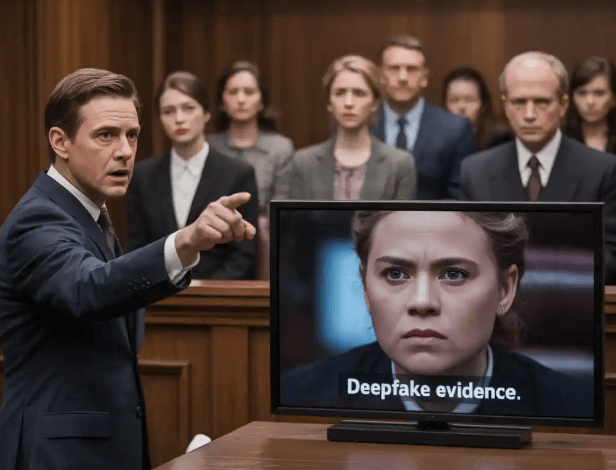Deepfakes in Courtrooms: Navigating Truth in the Age of Synthetic Media

Deepfakes have become one of the most compelling threats to truth and justice in an era of content that can be manipulated in petrifying degrees of realism. Having long been an internet fringe phenomenon, deepfakes hyper-realistic video or audio recordings created using artificial intelligence are being presented, challenged, and examined in a court of law around the globe. With such synthetic media finding their way into the legal system, courts are now encountering unprecedented challenges regarding the true nature of evidence, the validity of the AI-generated content, and the formulation of brand-new sets of laws to prosecute deepfakes.
The Emergence of Deepfakes: A Legal Puzzle
Deepfakes are the means of substituting or editing faces, voices, or actions in video or audio recordings using deep learning algorithms. The technology possesses great potential uses, like in movie making or even learning, but at the same time it can do a tremendous amount of harm. Whether it is political misinformation, revenge porn, or just trolling, deepfakes have proven now to be capable of deception, manipulation, and exploitation.
They are now appearing in courts.
The recent court cases involving deepfakes have shown that an increasing number of people are submitting fake videos as evidence, or are using synthetic audio to mimic victims, or alleging that real videos have been manipulated with deepfake technology. This two-fold danger of the false media being seen as true and true media being viewed as false is a peculiar problem to courts and counselors.
Deepfakes as Evidence: Authenticity is on Trial
Admissibility of video and audio evidence is one of the fundamental questions that concern the legality of deepfakes in courtrooms. Traditionally, the courts have been grounded in the idea that recordings are largely unedited, and are generally analogous to reality. Deepfakes however bust that myth. How can a court prove reality when a video can be completely falsified to depict an individual saying or doing something he/she never said or did?
Courts have now been compelled to introduce improved forensic analysis in order to ascertain authenticity of media. Such tools as deepfake detection software and digital watermarking have become essential in the process of authenticating the content. Yet, such tools are not infallible, and specialist witnesses are usually called upon to bear witness regarding the soundness of digital evidence.
A New Frontier of Prosecuting Deepfakes in Criminal Law
The increasing refinement of synthetic media has led to it being the subject of litigation in a number of high-profile deepfake lawsuits. As an example, people have been charged with making doctored videos to set up or blackmail people. In 2023, a man in the United States was indicted when he produced a deepfake audio recording to pose as a local official leading to outcry among people and mayor disrupted the local governance.
Nevertheless, deepfake prosecutions are not always easy to come by. Jurisdictional problems are also common, particularly in the cases of cross-border sharing of the content. Also, existing legislation might not be comprehensive enough to deal with the unique harms posed by deepfakes and prosecutors might have to refer to other general crimes like fraud, harassment, or defamation.
Deepfake Legislation: The Game is Catching-Up
Although it is increasingly becoming common to enact laws against deepfakes in certain countries, most legal frameworks are in the process of catching up. In the United States, regulation of deepfake creation and distribution consists of a patchwork of state laws. For example:
There are state laws in California and Texas prohibiting deepfakes to be used to influence elections.
Virginia makes using deepfakes to create nonconsensual pornography a crime.
Bills to address synthetic media that is deployed to commit fraud or to impersonate have been proposed in other states.
On a federal level, proposed bills such as the DEEPFAKES Accountability Act would require any AI-generated content to be clearly labeled and include criminal punishment options should it be used maliciously. But, federal deepfake law is still in transition.
In the global market, such countries as China have introduced far-reaching regulation of deepfake, which is to watermark synthetic media and make creators responsible. Provisions in the AI Act of the European Union are also aimed at policing the misuse of generative AI in the production of content.
Nevertheless, the speed of the legislation is not fast enough to keep up with the speedy development of the technology.
Deepfake Regulation in the Courtroom: Finding the Proper Balance
Proper deepfake regulation within the courtroom should aim at balancing between the reduction of unlawful use and retention of the lawful uses of synthetic media. There is an increasing concern among judges to address the credibility of evidence which can be manipulated, and to this end, many ask to standardise the procedures in digital evidence verification.
To solve this, legal experts are calling to include digital literacy training of judges and attorneys, the use of AI forensics in all court rooms, and better rules on how to use and challenge synthetic evidence.
Other legal experts have even suggested the establishment of specialized so-called digital evidence courts where more technologically demanding cases could be dealt with by jurists with a legal and technical background. This would assist in avoiding the unfair conviction or rejection founded due to misunderstood media.
Conclusion: What is the Future of Justice in Synthetic World?
The legal system needs to change with deepfake detection as they keep getting more advanced. Modernizing deepfake legislation and funding the development of detection technology, educating legal practitioners and elucidating evidentiary thresholds are just a few things that need to be done.
The once holy domain of truth, the courtroom, has to be defended now against a digital onslaught the like of which we now cannot see but believe. The future course needs watchfulness, creativity and a dedication to the fact that justice must not be compromised by artificial misrepresentation.
The legal world is at the beginning of a new frontier whether in prosecution of deepfakes, examination of suspicious recording, or creation of sweeping deepfake regulation. It is not only how deepfakes will be treated in courts but whether courts will even be able to maintain the integrity of justice in a society where truth too can be faked.





